Dr. Jones
Newly Enlightened
In the early 1980s, Duracell, at that time strictly a battery manufacturer, commissioned famed British industrial designer Nick Butler to create a novel flashlight for them: the Duracell Durabeam. Butler's story can be found at this link:
https://www.woudhuysen.com/nick-butler-a-product-designer-as-an-anti-hero/
…with mention of his work with Duracell found halfway down the page.
Taking a cue no doubt from another iconic design, the Zippo lighter, the flashlight turns on when opened and goes out when closed; the uncomplicated yet ingenious switching mechanism, made from formed beryllium copper strips is internal and completely contained in the head. The design is considered a classic, and even rates a spot in the collection of the Museum of Modern Art:
https://www.moma.org/collection/works/82138
Two versions were manufactured: one that takes a pair of AA batteries, and a larger version which uses C cells. The reflector and clear cover are plastic, and changing the bulb (which in the AA version is the venerable #222, and in the C type a rather oddly-shaped 2.4V, 0.5A, prefocused flange-base and unnumbered wasp-waisted bulb, see photo) is performed by prying off the clear cover from the bottom, inserting a new bulb and replacing the cover, which snaps into place.
The pair you see here were purchased in 1983 in the U.S., where they had just begun to be marketed. The smaller light rode in my jacket pocket for years, and is about the handiest flashlight I've ever used. The fact that they can stand up or lie down, combined with the ability to aim the head where light is needed, makes them extremely versatile; these certainly won't roll away on you! Absolutely the bee's knees for reading a map under a dark rainforest canopy.
The only issue that I've ever had with them has been poor contact in the switch mechanism; as they are bare, uncoated beryllium copper, they tend to suffer from oxidation when sitting unused for a while, but working the lamp head back and forth a dozen or so times usually cleans them right up. The switch mechanism area within the head is for all intents and purposes inaccessible, unless one feels extraordinarily lucky and wants to attempt opening the head without damaging it, and although I'm sure a spray of De-Oxit would likely help matters, I've never really felt the need to apply such.
Considering that literally millions of these flashlights were produced in the early to mid-80s, they are quite difficult to find today; I suspect that most people who bought them either wore them out or have since held on to them for their wonderful and compact utility. Also, they apparently were considerably more popular in Europe, particularly the UK, than in North America. I lucked out a few years ago in obtaining a NOS AA model, still in its original packaging. As Duracell, being primarily a battery manufacturer, almost always included batteries with its flashlights, this package came true-to-form with a pair of alkaline AA cells, but over the decades they went the way of all flesh and leaked, thankfully not injuring the flashlight itself, although the paper insert was a bit worse for wear.
It's a shame that these are no longer being produced; Duracell did make a type of flip light many years later, but it was a pale simulacrum of the Butler design. Like all things, perhaps it's time had just come and gone - heck, I feel that way about myself most days!
https://www.woudhuysen.com/nick-butler-a-product-designer-as-an-anti-hero/
…with mention of his work with Duracell found halfway down the page.
Taking a cue no doubt from another iconic design, the Zippo lighter, the flashlight turns on when opened and goes out when closed; the uncomplicated yet ingenious switching mechanism, made from formed beryllium copper strips is internal and completely contained in the head. The design is considered a classic, and even rates a spot in the collection of the Museum of Modern Art:
https://www.moma.org/collection/works/82138
Two versions were manufactured: one that takes a pair of AA batteries, and a larger version which uses C cells. The reflector and clear cover are plastic, and changing the bulb (which in the AA version is the venerable #222, and in the C type a rather oddly-shaped 2.4V, 0.5A, prefocused flange-base and unnumbered wasp-waisted bulb, see photo) is performed by prying off the clear cover from the bottom, inserting a new bulb and replacing the cover, which snaps into place.
The pair you see here were purchased in 1983 in the U.S., where they had just begun to be marketed. The smaller light rode in my jacket pocket for years, and is about the handiest flashlight I've ever used. The fact that they can stand up or lie down, combined with the ability to aim the head where light is needed, makes them extremely versatile; these certainly won't roll away on you! Absolutely the bee's knees for reading a map under a dark rainforest canopy.
The only issue that I've ever had with them has been poor contact in the switch mechanism; as they are bare, uncoated beryllium copper, they tend to suffer from oxidation when sitting unused for a while, but working the lamp head back and forth a dozen or so times usually cleans them right up. The switch mechanism area within the head is for all intents and purposes inaccessible, unless one feels extraordinarily lucky and wants to attempt opening the head without damaging it, and although I'm sure a spray of De-Oxit would likely help matters, I've never really felt the need to apply such.
Considering that literally millions of these flashlights were produced in the early to mid-80s, they are quite difficult to find today; I suspect that most people who bought them either wore them out or have since held on to them for their wonderful and compact utility. Also, they apparently were considerably more popular in Europe, particularly the UK, than in North America. I lucked out a few years ago in obtaining a NOS AA model, still in its original packaging. As Duracell, being primarily a battery manufacturer, almost always included batteries with its flashlights, this package came true-to-form with a pair of alkaline AA cells, but over the decades they went the way of all flesh and leaked, thankfully not injuring the flashlight itself, although the paper insert was a bit worse for wear.
It's a shame that these are no longer being produced; Duracell did make a type of flip light many years later, but it was a pale simulacrum of the Butler design. Like all things, perhaps it's time had just come and gone - heck, I feel that way about myself most days!
Attachments
-
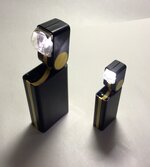 2785A449-F0A0-4D53-9601-8EBA28C02CED.jpeg242.3 KB · Views: 40
2785A449-F0A0-4D53-9601-8EBA28C02CED.jpeg242.3 KB · Views: 40 -
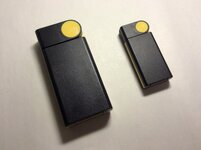 6A082162-4F8D-4D56-AD49-99B3E6A90356.jpeg305.4 KB · Views: 23
6A082162-4F8D-4D56-AD49-99B3E6A90356.jpeg305.4 KB · Views: 23 -
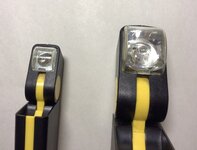 8AEA0CEC-BAE5-42E0-A180-456A655C3403.jpeg319.3 KB · Views: 27
8AEA0CEC-BAE5-42E0-A180-456A655C3403.jpeg319.3 KB · Views: 27 -
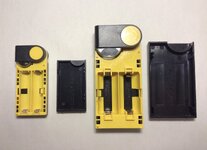 333119DB-223F-45E7-845A-157A05F28B59.jpeg298.6 KB · Views: 24
333119DB-223F-45E7-845A-157A05F28B59.jpeg298.6 KB · Views: 24 -
 A3C9AEC9-9792-4808-B716-5E769D1D98A4.jpeg284.3 KB · Views: 21
A3C9AEC9-9792-4808-B716-5E769D1D98A4.jpeg284.3 KB · Views: 21 -
 717E9994-C314-4E69-8EE5-0D7A25DCBD3A.jpeg305.2 KB · Views: 33
717E9994-C314-4E69-8EE5-0D7A25DCBD3A.jpeg305.2 KB · Views: 33 -
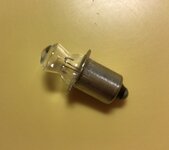 8B4753F9-7624-402E-A39B-D5AF9C30F64A.jpeg266.1 KB · Views: 27
8B4753F9-7624-402E-A39B-D5AF9C30F64A.jpeg266.1 KB · Views: 27
Last edited:

